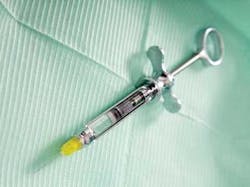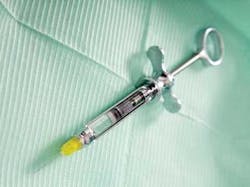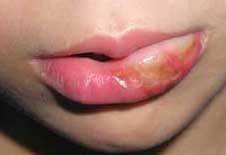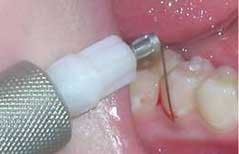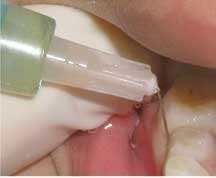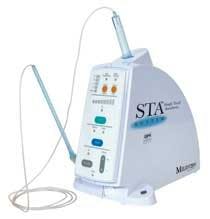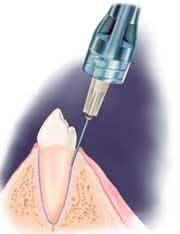Tricks and Techniques —Painless shots: An oxymoron?
by Fred S. Margolis, DDS, FICD, FACD, FADI, Pediatric dentist
For more on this topic, go to www.dentaleconomics.com and search using the following key words: financial crisis, multiplier effect, mortgage debt, mortgage brokers, mortgage–backed investments, financial institutions, commercial paper, meltdown, Great Depression, Wall Street, AIG, bailout, Rick Willeford.
Ask parents the one thing they would appreciate that their child's dentist do when restoring their child's teeth and most would answer, "Give shots that don't hurt."
Can we deliver painless anesthesia? Can we provide local anesthesia in a painless manner and in such a way that the child does not have anesthesia to the lip, tongue, and cheek? Can we provide profound anesthesia without worrying about toxicity from the local anesthetic we administer? Can painless injections lead to less stress and anxiety for the patient, parent, and dentist? The answer to all of these questions is yes, and I will review several tricks and techniques for providing less painful dentistry using less anesthetic and without the postop numbing effects of mandibular blocks and maxillary infiltrations (Figure 1).
Topical anesthetics — do they work?
Take the time to try your topical anesthetics in your own mouth. Make the following observations: What does it taste like? How long does it take to numb your tongue? Does is take 30 seconds, 60 seconds, or longer? If we are going to use a topical anesthetic, let us use it effectively and leave it on the mucosa for the optimal time period. There are pharmacies that will compound topical anesthetics that are safe and extremely effective.
I have used Profound topical anesthetic (Stevens Pharmacy, Costa Mesa, Calif.), which is a combination of tetracaine, lidocaine, and prilocaine. It has helped dentists perform pain–free injections. Two minutes is the optimal time to let it work. Several methods can provide less–painful anesthesia without concomitant numbing of the patient's lip, tongue, and/or cheek —
- Erbium laser
- Intrasulcular anesthesia
- STA system
The Erbium laser
The Waterlase® MD (Biolase, Irvine, Calif.) Erbium laser can provide laser "conditioning" of the tooth. Laser conditioning is a term I have coined for laser analgesia. More than 90% of my patients do not require local anesthesia for cavity preps, pulp therapy, or stainless steel crown preparations. My teenage patients report a "tingling" or "cold" sensation while I prepare their teeth. I have used the Erbium laser in my pediatric practice for more than eight years, and patients and their parents are very pleased about this more comfortable method for preparing childrens' teeth (Figure 2).
Intrasulcular injection technique — the periodontal syringe
There are several dental manufacturers that offer periodontal ligament injection syringes. The periodontal ligament syringe has the benefit of enabling the dentist to anesthetize one or several teeth without the use of block anesthesia. For example, a periodontal syringe can be used to anesthetize a primary molar or bicuspid by placing the needle into the sulcus and injecting slowly when the tip of the needle is at the crestal bone. This provides anesthesia without going into the periodontal ligament space, which prevents postoperative pain. In using this technique for more than 15 years, I have found that it can anesthetize an individual tooth in less than one minute without concomitant numbing of the lip, tongue, and cheek (Figure 3).
The use of a plastic–hubbed, 30–gauge needle will hermetically seal the anesthetic solution without allowing it to drip into the mouth. The advantage of an enclosed anesthetic carpule is protection in case the glass carpule breaks under excessive pressure. In my practice, I use the Paroject® (Septodont, New Castle, Del.) (Figure 4).
Intraligamentary anesthesia — STA system
Milestone Scientific Corporation has a new single–tooth anesthesia device (STA™ by Milestone Scientific, Livingston, N.J.), that has remarkable benefits for dentists and patients —
- Computerized control of the flow rate of anesthetic delivery and the pressure applied when giving the injection
- Computerized dosage of the amount of local anesthesia injected
- Specially designed needle specific for the intraligamentary injection
- Rapid onset of anesthesia
- Only the tooth and surrounding gingiva are anesthetized
- Can be used for AMSA and P–ASA block anesthesia, if desired (Figure 5 is the PDL injection, not the ASA or PSA)
- Less anesthesia is required and therefore no worries about toxicity
- Multiple–quadrant dentistry saves time and increases production
Ashkenazi, et al., in a study of 193 children ages two to 13, found that "Most children exhibited low pain–related behavior during anesthesia administration" when using computerized delivery of intrasulcular anesthetic in primary molars.1 A study by Oztas, et al., compared children's reactions to an inferior alveolar nerve injection with a traditional syringe and a periodontal ligament injection with a computerized device, the Wand™ (Milestone Scientific). The study assessed the efficacy of the anesthesia and the patient's reaction after treatment. "The overwhelming majority of patients favored the periodontal ligament injection with the Wand."2
Fear of the injection and the dental procedures
In their study, Jalevik, et al., point out that where the sensation of pain was compared utilizing the Wand versus conventional local anesthesia techniques, "computerized injection technique ... was less painful compared to conventional injection techniques, especially among those who reported fear for injections."3
A wonderful aspect of the STA system is that the Wand handpiece does not look like a typical local anesthetic aspirating syringe. It resembles a pen with a length of tubing attached (Figure 6).
Which local anesthetic should I use?
Clinical studies have shown that the use of 4% articaine can increase the probability of success for intraligamentary injections.4 This has been shown to provide effective pulpal anesthesia in scientific studies.5
One of the advantages of 4% articaine 1:200,000 vasoconstrictor is that only half the time is required to perform the injection compared to using 2% lidocaine, according to Dr. Mark Hochman.6
How does the STA system work?
The STA/intraligamentary injection uses the PDL space as the injection site. Using the ControlFlo rate, anesthetic solution travels via the periodontal ligament and associated "space" through the cribriform plate into the medullary bone surrounding the apical region of the tooth, achieving predictably successful anesthesia with almost immediate onset and significantly longer duration of anesthesia (Figure 7).
By providing real–time visual and audible feedback using DPS (Dynamic Pressure Sensing) technology, the STA allows the dentist to accurately identify the intraligamentary tissue. Throughout the injection, the DPS continuously monitors the pressure during all phases of the administration to ensure proper needle position.
Other dentists report on the STA system
Dr. William Lieberman, past president of the American Society of Dentistry for Children, noted that by using the STA instrument, lip biting post–anesthesia has been eliminated.
He also noticed that his patients were more cooperative due to less stress and fear because they did not even realize they were having a "shot."7 Dr. Marty Jablow, a general dentist who often lectures on high–tech dentistry, said, "STA allows me to begin every injection technique with significantly less stress for me and my patient."8
Conclusion
The "Golden Age" of dentistry is the here and now when it comes to the many innovations available. This allows us to practice pain–free dentistry, increase our livelihood by practicing multiquadrant dentistry, and keep our patients and their parents happy! Doing so leads to less stress and more fun while performing our dentistry, which also leads to less burnout and more rewarding careers.
References are available upon request, and will also be posted online at http://www.dentaleconomics.com. Click on "Resource Center," then "Download Center."
Dr. Fred Margolis has lectured both nationally and internationally. He is in full–time private practice of pediatric dentistry in Buffalo Grove, Ill. Dr. Margolis can be reached at [email protected] or by phone at (847) 537–7695.
Gender differences in reported dental fear and fear of dental pain
Gender differences in dental fear have been of increasing interest among clinicians and researchers. In a study by Heft, Meng, Bradley, and Lang, published in Community Dentistry and Oral Epidemiology Vol. 35, No. 6, Dec. 2007, pp. 421–428, the authors assessed gender differences in reports of global dental fear, global fear of dental pain, and specific fear of dental pain. A telephonic survey of 504 adult Floridians was conducted in 2004.
"Women were more likely to report global dental fear, global fear of dental pain, and specific fear of dental pain than men, and both women and men were more likely to report ‘dread' of dental pain than ‘fear' of dental pain." The authors concluded that both men and women are more willing to express their feelings of dental fear using a more "socially acceptable" term.
(Editor's Note: All of the adults surveyed were once children.)
